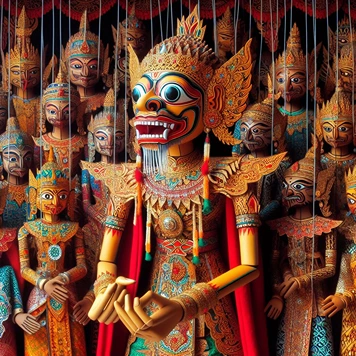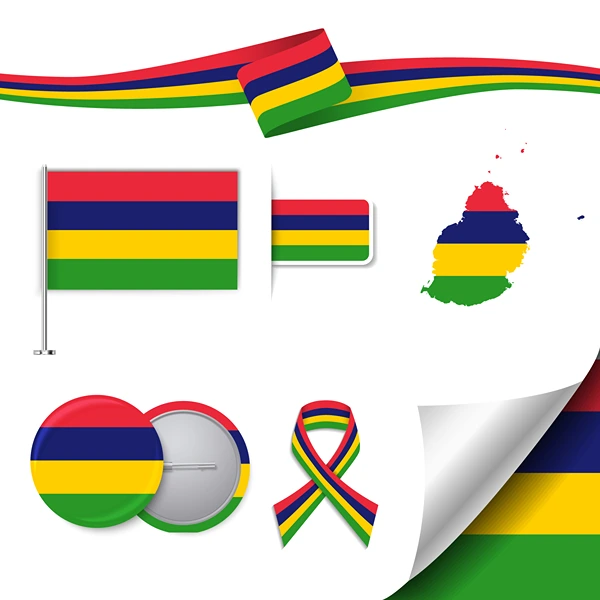Wayang Golek, a traditional Indonesian puppetry form, has played a significant role in the cultural and religious landscape of Indonesia. While primarily known for its entertainment value, Wayang Golek has also been instrumental in conveying religious messages, particularly in the context of the spread of Islam in the archipelago.
Historical Background:
Wayang Golek, deeply rooted in the ancient traditions of Java and Sunda in Indonesia, carries a profound historical legacy. Originating from a bygone era, this traditional art form is a captivating spectacle that centers around intricately designed wooden puppets. These puppets, deftly manipulated by skilled puppeteers, become the storytellers, bringing to life narratives sourced from epics, legends, and religious texts.
The craftsmanship of the wooden puppets is remarkable, reflecting the artistic finesse and cultural intricacies of the Javanese and Sundanese traditions. The puppeteers, often regarded as masters of their craft, skillfully animate the characters, infusing them with life and personality. The visual allure of Wayang Golek is heightened by the vibrant colors, elaborate costumes, and expressive movements of the puppets.
However, Wayang Golek is not merely a form of entertainment; it serves a more profound purpose as a conduit for cultural preservation and spiritual expression. The narratives enacted by the puppets transcend mere storytelling; they carry moral lessons and religious teachings. Through these performances, audiences are not only entertained but also educated, gaining insights into the values, ethics, and spiritual beliefs embedded in the tales.
The choice of stories often includes themes from epics and legends that are culturally significant. Additionally, religious texts, particularly those conveying moral and ethical teachings, are seamlessly woven into the performances. This synthesis of entertainment, cultural preservation, and spiritual instruction makes Wayang Golek a multifaceted art form, deeply intertwined with the historical and cultural fabric of Indonesia.
In essence, Wayang Golek is a living testament to the artistic ingenuity and cultural heritage of Java and Sunda. Its continued existence and relevance highlight the enduring appeal of this traditional puppetry, which not only entertains but also serves as a bridge between the past and the present, preserving the rich tapestry of Indonesia’s cultural and spiritual history.
Spread of Islam through Wayang Golek:
Centuries ago, as Islam found its path to Indonesia, a significant cultural and religious fusion unfolded through the integration of Wayang Golek with Islamic teachings. Puppeteers, recognizing the potential of this traditional art form, embarked on adapting its narratives to encompass Islamic stories. This adaptation prominently highlighted the life and teachings of Prophet Muhammad, the Companions, and various other important figures in Islam.
The puppeteers, masters of their craft, skillfully infused these Islamic elements into the traditional tales, creating a creative synthesis that resonated with the local population. Through the medium of Wayang Golek, the stories of Islam became more than historical accounts; they transformed into engaging narratives that were accessible and relatable to diverse audiences.
This strategic amalgamation of Wayang Golek with Islamic narratives played a pivotal role in making the teachings of Islam more understandable and appealing to the people of Indonesia. The visual and performative aspects of the puppetry added a dynamic and captivating dimension to the religious stories, facilitating a deeper connection with the audience.
As a result, Wayang Golek became a powerful tool for both entertainment and education, fostering a unique cultural bridge between traditional Javanese and Sundanese practices and the newly introduced Islamic teachings. This integration not only facilitated the spread of Islam but also contributed to the cultural enrichment of Indonesia, showcasing the adaptability of local artistic forms in embracing and disseminating religious beliefs.
Cultural Syncretism:
Centuries ago, as Islam found its path to Indonesia, a significant cultural and religious fusion unfolded through the integration of Wayang Golek with Islamic teachings. Puppeteers, recognizing the potential of this traditional art form, embarked on adapting its narratives to encompass Islamic stories. This adaptation prominently highlighted the life and teachings of Prophet Muhammad, the Companions, and various other important figures in Islam.
The puppeteers, masters of their craft, skillfully infused these Islamic elements into the traditional tales, creating a creative synthesis that resonated with the local population. Through the medium of Wayang Golek, the stories of Islam became more than historical accounts; they transformed into engaging narratives that were accessible and relatable to diverse audiences.
This strategic amalgamation of Wayang Golek with Islamic narratives played a pivotal role in making the teachings of Islam more understandable and appealing to the people of Indonesia. The visual and performative aspects of the puppetry added a dynamic and captivating dimension to the religious stories, facilitating a deeper connection with the audience.
As a result, Wayang Golek became a powerful tool for both entertainment and education, fostering a unique cultural bridge between traditional Javanese and Sundanese practices and the newly introduced Islamic teachings. This integration not only facilitated the spread of Islam but also contributed to the cultural enrichment of Indonesia, showcasing the adaptability of local artistic forms in embracing and disseminating religious beliefs.
Education and Moral Values:
A notable facet of Wayang Golek lies in its capacity to impart intricate moral and ethical lessons through compelling storytelling. Islamic values, including compassion, justice, and humility, are intricately woven into the narratives, offering audiences more than mere entertainment – they receive valuable lessons applicable to daily life. This educational dimension of Wayang Golek has played a pivotal role in shaping the moral foundation of Indonesian society.
The puppetry performances serve as a captivating medium through which complex moral concepts are distilled into accessible and engaging stories. The characters in Wayang Golek embody virtues and vices, allowing the audience to reflect on ethical dilemmas and the consequences of their actions. This narrative approach not only entertains but also stimulates thoughtful contemplation on the principles that guide a virtuous life.
The incorporation of Islamic values into Wayang Golek is not didactic; instead, it seamlessly integrates these principles into the fabric of the stories, making them a natural part of the cultural narrative. As a result, audiences, young and old, are exposed to a form of entertainment that serves a dual purpose – providing enjoyment and instilling a sense of moral responsibility.
This educational aspect of Wayang Golek has proven to be particularly influential, as it reaches a broad audience, transcending age, background, and literacy levels. Through the power of storytelling and visual representation, Wayang Golek contributes to the moral and ethical development of individuals, fostering a shared understanding of values that are integral to the cultural identity of Indonesia.
In essence, Wayang Golek stands not only as a testament to artistic expression but also as a revered teacher, imparting timeless lessons that resonate with the core values of compassion, justice, and humility embedded in Islamic teachings. The enduring impact of this educational aspect continues to contribute to the cultivation of a morally conscious and ethically grounded society in Indonesia.
Preservation and Challenges:
Despite its profound historical significance, Wayang Golek confronts challenges in the contemporary era. Shifting cultural preferences, technological advancements, and the swift urbanization pace present formidable threats to this traditional art form. Recognizing its cultural, historical, and religious importance, ongoing efforts are being made to preserve and promote Wayang Golek.
In the face of evolving cultural tastes, the popularity of traditional art forms like Wayang Golek has waned. Modern entertainment options and changing audience preferences pose a risk to the continued appreciation of this centuries-old puppetry. Additionally, the advent of technology has introduced new forms of entertainment that compete for attention, further marginalizing traditional art forms.
Urbanization, with its rapid expansion and cultural shifts, also contributes to the challenges faced by Wayang Golek. The traditional settings and community-based practices that once nurtured this art form are gradually giving way to urban landscapes, potentially disconnecting future generations from their cultural roots.
However, recognizing the imminent threats, concerted efforts are underway to ensure the preservation and promotion of Wayang Golek. Cultural enthusiasts, scholars, and government initiatives are collaborating to create awareness about the historical and religious significance of this art form. Educational programs are being implemented to introduce Wayang Golek to new generations, fostering an appreciation for its unique cultural value.
In addition, adapting Wayang Golek to contemporary contexts and incorporating it into modern platforms is explored as a strategy to attract a wider audience. Collaborations between traditional puppeteers and modern media aim to blend the rich heritage of Wayang Golek with innovative approaches to keep it relevant in the digital age.
Preservation efforts also involve documenting and archiving performances, ensuring that the knowledge and techniques associated with Wayang Golek are preserved for future generations. Museums, cultural institutions, and dedicated practitioners are working together to safeguard the tangible and intangible aspects of this traditional art.
In conclusion, while Wayang Golek faces challenges in the modern era, ongoing initiatives underscore its enduring cultural, historical, and religious importance. By adapting to contemporary contexts and leveraging educational and technological avenues, there is hope that Wayang Golek will not only survive but continue to thrive as a vital part of Indonesia’s rich cultural heritage.
Wayang Golek stands as a testament to the cultural resilience of Indonesia and the dynamic interplay between tradition and religion. As an art form that has adapted to convey Islamic teachings, it continues to be a vital cultural asset in Indonesia, fostering a unique synthesis of tradition, art, and spirituality. Efforts to preserve and promote Wayang Golek are crucial for ensuring that future generations can appreciate its role in the rich tapestry of Indonesia’s cultural and religious heritage.




